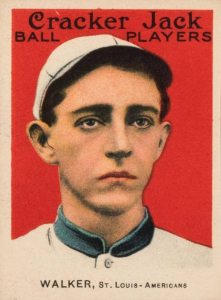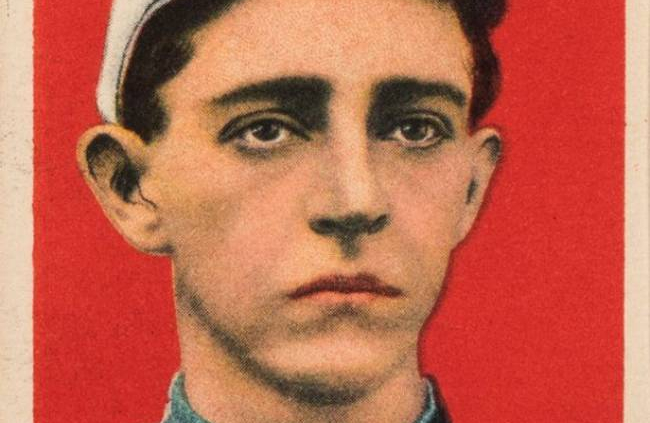May 20, 1918: Four late-game comebacks result in dizzying victory for A’s
 The 1918 season did not start well for either the Philadelphia Athletics or the Detroit Tigers. After a month the two teams found themselves at the bottom of the American League standings. On May 20 they met for the first time to play a four-game series.1 For the A’s, the games provided an opportunity to put some distance between themselves and the cellar-dwelling Tigers. For Detroit it was a chance to trade places in the standings with Philadelphia. As added incentive, Detroit manager Hughie Jennings promised his players that if they won three of the four games, he would buy them each a straw hat.2
The 1918 season did not start well for either the Philadelphia Athletics or the Detroit Tigers. After a month the two teams found themselves at the bottom of the American League standings. On May 20 they met for the first time to play a four-game series.1 For the A’s, the games provided an opportunity to put some distance between themselves and the cellar-dwelling Tigers. For Detroit it was a chance to trade places in the standings with Philadelphia. As added incentive, Detroit manager Hughie Jennings promised his players that if they won three of the four games, he would buy them each a straw hat.2
The game began well for the Athletics. Playing in front of hometown fans Connie Mack ‘s crew put a run on the board in the bottom first inning. More specifically, Manny Kopp put a run up for the Athletics. Batting second, he smacked a pitch over Detroit’s right fielder, Harry Heilmann, that rolled to the wall. Gliding into third with a triple, the speedy Kopp scored when Donie Bush, the Tigers shortstop, hopped his relay throw past third baseman Ossie Vitt. Bush, known for his defensive prowess, was acknowledged to be among the best shortstops in baseball but on this day, he began the game with a rare run-scoring error.
Neither team scored again until Harry Heilmann came to the plate in the Detroit fifth inning. To that point Athletics pitcher Elmer Myers had kept the Tigers hitless. Heilmann changed that by drilling a pitch into the left-field stands. It was his first home run of the season. He would hit four more before military service prematurely ended his season. With the American participation in World War I rapidly expanding, the government decreed that as of July 1 all men employed in nonessential occupations must either work in war-related jobs or be eligible for the military draft. Ballplayers were deemed nonessential. The edict was challenged but on July 19 the “work-or-fight” policy was upheld. As did several other players, including A’s shortstop Red Shannon, Heilmann immediately enlisted in the US Navy. Many other players chose to find jobs in war industries after the season ended.3 Babe Ruth, for instance, worked at a Bethlehem Steel plant in Lebanon, Pennsylvania. Of course, Heilmann was not thinking about future circumstances as he rounded the bases that day in Philadelphia. He had just tied the game.
The next inning Detroit added another run. Ty Cobb worked Meyers for a two-out walk. Cobb stole second and went to third on a wild pitch. Bobby Veach, the Tigers’ left fielder and cleanup hitter, followed Cobb to the plate. Veach, Cobb, and Heilmann, comprised arguably the best-hitting outfield in baseball. Veach was the RBI man of the trio. Two of the previous three years he had led the American League in RBIs and he was on his way to topping the league again in 1918. A gregarious, mild-mannered player, Veach did not fit Cobb’s image of a competitor even though he was one of the more feared power hitters in the American League. This time up he banged a Myers pitch off the knee of Philadelphia’s first baseman, George Burns, driving in Cobb with the go-ahead run.
Through the next three innings Myers dominated Tigers hitters. Meanwhile, the Athletics unsuccessfully pecked away at Detroit’s pitcher, George Dauss. Dubbed “Hooks” because he had such a good curveball, Dauss was a crafty pitcher who, despite giving up base hits, was able to keep Philadelphia off the scoreboard after the first inning.
The Athletics came to the plate in the bottom of the ninth still down a run. Burns led off with a single. Third baseman Larry Gardner, one of the few college graduates playing in the major leagues then, followed with a bunt single and shortstop Shannon walked, loading the bases with no one out. Philadelphia manager Connie Mack chose to pull Joe Dugan in favor of Rube Oldring. In the 1920s Jumpin’ Joe became the regular third baseman on the legendary Murderers’ Row Yankees teams, but in 1918 he was a sub-200 hitter who had yet to establish himself. His replacement bounced one back to Dauss who forced Burns at the plate. Next up was Wicky McAvoy, the A’s catcher, who dropped a Texas Leaguer into left. Gardner scampered home with the tying run but Shannon, unsure whether the ball would be caught, was forced at third. Dauss then got Myers to end the inning.
The Tigers retook the lead in the top of the 10th on a muffed infield fly. Bush led off with a groundball that shortstop Shannon booted. Ossie Vitt sacrificed Bush to second and Ty Cobb smacked a sharp line drive off Myers, sending Bush to third. With runners on the corners, the A’s intentionally walked the dangerous Veach and instead pitched to Heilmann. The strategy appeared to work. The Tigers right fielder popped one to Claude Davidson, who had replaced Dugan at second base. Perhaps Davidson simply misplayed the ball or perhaps he was trying to set up a double play and forgot about the infield-fly rule. Regardless, he let the ball drop. Bush took advantage of the mistake and streaked home with the go-ahead run.
Again, three outs away from a defeat, the A’s fought back. Right fielder Charlie Jamieson, a converted pitcher whose speed made him an excellent leadoff hitter, walked to start the 10th. Kopp sacrificed him to second and he scored on center fielder Tillie Walker’s single.
After a scoreless 11th inning, the Tigers got another run in the top of the 12th. With one out, singles by Vitt and Cobb put the go-ahead run on second base. As they had in the ninth, Mack and company chose to issue an intentional pass to the Tigers hard-hitting left fielder Bobby Veach and pitch to Heilmann. Again, the strategy backfired. Heilmann pounded a fly ball to Kopp in left field, enabling Vitt to score easily.
For the third time the Athletics found themselves at the brink of defeat and for the third time they avoided it. This time with a bit of controversy. With one out in the bottom of the inning, Walker and Burns singled. Next, Gardner hit a tailor-made double-play ball back to Dauss on the mound. Dauss fired to Vitt at third who pegged one across the diamond to Lee Dressen at first, apparently getting Gardner by a couple of steps, according to the Tigers.4 Umpire Brick Owens, who “couldn’t bear to see Gardner perish on the last end of a double play,” disagreed.5 Instead, he called Gardiner safe. One batter later, Burns trotted home with the tying run on Shannon’s single.
The closest thing to a threat either team offered in the 13th was a long fly ball off the bat of Detroit’s Ossie Vitt that Kopp hauled in just in front of the left-field wall. The Tigers again went quietly in the 14th. The Athletics did not.
As evening shadows began to stretch across Shibe Park, Manny Kopp opened the inning with a walk. One out later he stole second. Pitching carefully to Burns, who already had four hits, Dauss plunked him on the thigh. Gardner then shot a single to right that filled the bases. With one out, Red Shannon came to the plate with a chance to be a hero. Instead he popped up to Young at second. As light-hitting Claude Davidson approached the plate, it appeared that Detroit might escape the threat. Dauss’s first two pitches were both strikes. Then on the third pitch Kopp took things into his own hands. As Dauss went into his windup the fleet-footed left fielder broke for the plate. The pitch came in low and outside, enabling Kopp’s “feet-first slide (to) beat the pitch to the plate.”6 So ended “the wildest, weirdest and most nerve-racking battle seen this year.”7
Of the 4,500 spectators still in Shibe Park, none was more excited than the usually composed Connie Mack. Commented a sportswriter, “It was the first time in history we have seen Connie Mack leave the players’ bench to grasp one of his athletes by the hand and slap him on the back for winning a ball game.”8
SOURCES
In addition to the sources cited in the Notes, the author accessed Retrosheet.org, Baseball-Reference.com, and SABR.org.
NOTES
1 Only two games of the four-game series were played. Tuesday’s game was rained out and made up on July 6. Thursday’s game was also rained out and made up on July 23, in a six-game series.
2 Harry Bullion, “Told About Tigers,” Detroit Free Press, May 21, 1918: 11.
3 The War Department allowed the major leagues until September 1 to complete the regular season before players would be drafted.
4 Harry Bullion, “Kopp Steals Home to Win Long Battle,” Detroit Free Press, May 21, 1918: 11.
5 Bullion, “Kopp Steals Home to Win Long Battle.”
6 Jim Nasium, “Mannie Kopp Stealing Home with Two Out in the 14th Wins for Mackmen,” Philadelphia Inquirer, May 21, 1918: 12.
7 Robert W. Maxwell, “Jackson and Others Who Sought Deferred Classification Ordered to Report for Army Duty at Once,” Philadelphia Evening Public Ledger, May 21, 1918: 12.
8 Jim Nasium.
Additional Stats
Philadelphia Athletics 5
Detroit Tigers 4
14 innings
Shibe Park
Philadelphia, PA
Box Score + PBP:
Corrections? Additions?
If you can help us improve this game story, contact us.


